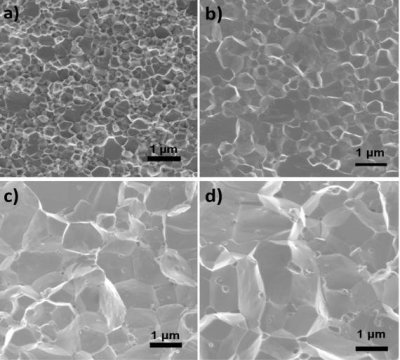Nov
22
New Material To Convert Heat to Electricity
November 22, 2016 | 1 Comment
University of Houston researchers are reporting that they have demonstrated a step forward in converting waste heat – from industrial smokestacks, power generating plants or even automobile tailpipes – into electricity. With energy conservation expected to play a growing role in managing global demand, materials and methods that make better use of existing sources of energy have become increasingly important.
The team’s study paper, published in Proceedings of the National Academy of Sciences shows they have demonstrated a step forward in converting waste heat – from industrial smokestacks, power generating plants or even automobile tailpipes – into electricity.

SEM images of the material hot-pressed at a) 1123 K, b)1173 K, c) 1273 K, and d)1373 K. Image Credit: University of Houston. Click image for the largest view.
The work, using a thermoelectric compound composed of niobium, titanium, iron and antimony, succeeded in raising the material’s power output density dramatically by using a very hot pressing temperature – up to 1373 Kelvin, or about 2,000º Fahrenheit – to create the material.
Quoted in the press release the team said in the paper, “The majority of industrial energy input is lost as waste heat. Converting some of the waste heat into useful electrical power will lead to the reduction of fossil fuel consumption and CO2 emission.”
Thermoelectric materials produce electricity by exploiting the flow of heat current from a warmer area to a cooler area, and their efficiency is calculated as the measure of how well the material converts heat – often waste heat generated by power plants or other industrial processes – into power. For example, a material that takes in 100 watts of heat and produces 10 watts of electricity has an efficiency rate of 10 percent.
Zhifeng Ren, MD Anderson Professor of Physics at the University of Houston and lead author of the paper said that’s the traditional way of considering thermoelectric materials But having a relatively high conversion efficiency doesn’t guarantee a high power output, which measures the amount of power produced by the material rather than the rate of the conversion.
Because waste heat is an abundant – and “free” (already charged off having done some other work) – source of fuel, the conversion rate is less important than the total amount of power that can be produced, said Ren, who is also a principal investigator at the Texas Center for Superconductivity at UH. “In the past, that has not been emphasized.”
The researchers tweaked a compound made up of niobium, iron and antimony, replacing between 4 and 5 percent of the niobium with titanium. Processing the new compound at a variety of high temperatures suggested that a very high temperature – 1373 Kelvin – resulted in a material with an unusually high power factor.
“For most thermoelectric materials, a power factor of 40 is good,” Ren said. “Many have a power factor of 20 or 30.”
The new material has a power factor of 106 at room temperature, and researchers were able to demonstrate an output power density of 22 watts per square centimeter, far higher than the 5 to 6 watts typically produced, he said.
“This aspect of thermoelectrics needs to be emphasized,” he said. “You can’t just look at the efficiency. You have to look also at the power factor and power output.”
106? 22 watts per square centimeter? Is that a breakthrough or a miracle? Whichever, it is extremely good news. Congratulations!!!
In addition to Ren, researchers involved in the project include Ran He, Jun Mao, Qing Jie, Jing Shuai, Hee Seok Kim, Yuan Liu and Paul C.W. Chu, all of UH; Daniel Kraemer, Lingping Zeng and Gang Chen of the Massachusetts Institute of Technology; Yucheng Lan of Morgan State University, and Chunhua Li and David Broido of Boston College.
Comments
1 Comment so far


Heat is heat. Lighten up on the waste heat argument and focus on the science and the numbers.
Like the highly implausible 22 watts per square centimeter. Even 5 watts per sq centimeter is nonsense.